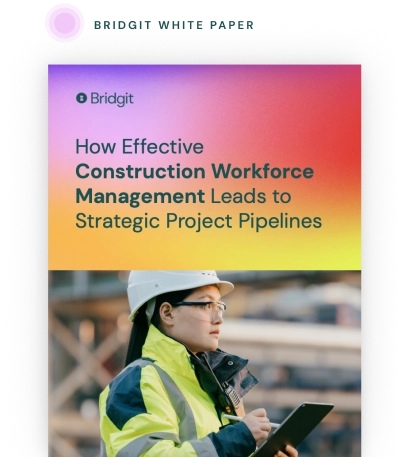Feasibility studies play a crucial role in the construction project management process. They help companies map out the road ahead and determine whether desired outcomes are in line with reality.
Table of Contents
Keep reading to learn more about conducting a feasibility study in construction, including risks to account for.
What is the purpose of a feasibility study in construction?
Feasibility studies help general contractors and clients determine whether a project is feasible. Whatever the answer may be, a feasibility study will provide concrete data explaining the basis for its conclusion.
It will also provide options for ensuring the project remains feasible, which will shape documents such as the execution plan and strategic brief.
On larger projects, it’s not uncommon for there to be multiple project feasibility assessments pertaining to various aspects of the job, including:
-
environmental risks
-
the need for regulatory approval (and the likelihood of getting it within the stated timeline)
-
whether the client’s budget is sufficient
-
potential maintenance issues related to the design
-
procurement
Given the potential wide-reaching nature of a construction project feasibility assessment, it’s not uncommon for many stakeholders and even third parties such as regulators to be involved.
As such, when conducting a feasibility study for a construction project, it’s imperative to have a good working knowledge of the industry’s many moving parts.

Use your workforce data to create a competitive advantage
Download our white paper to see how effective workforce planning can help stay ahead of labor demands and create a strategic project pipeline.
The TELOS formula for conducting a feasibility study in construction
The TELOS formula is commonly used when conducting feasibility studies in project management. Writer James A. Hall introduced the concept in 2007 via his book Accounting Information Systems.” Since then, the TELOS formula has been adopted in a variety of industries, including.
Let’s take a closer look at what each letter of the acronym stands for.
Technological
Many of the construction industry’s biggest trends involve technological advancements. It should come as no surprise, then, that technology plays a key role in feasibility studies for construction projects.
In the context of the TELOS formula, technology consists of any systems necessary for the project’s success. You’ll want to make sure these systems are available as part of your construction resource planning.
If this presents a challenge, it should reflect in the conclusions of your feasibility study.
Keep in mind that larger construction projects may also come with the potential for developing entirely new construction technology (i.e. software). When a project requires such an undertaking, that should be reflected in the feasibility study as well.
Economics
Of course, money also plays a major role in construction. As part of your feasibility study, you’ll need to conduct a cost analysis to determine and address the project’s financial risks. That includes concerns such as getting paid on time and ensuring an accurate estimate to protect your company’s bottom line.
It probably goes without saying that the economics portion of a feasibility study is among the most important.
Legal
When conducting a feasibility study for a construction project, you’ll also need to identify any potential legal hurdles. Most substantial projects will have at least some regulatory concerns to address, such as acquiring the correct permits.
On large, complex projects, these regulatory concerns can be quite monumental, which underscores the importance of conducting a feasibility study to ensure they can be overcome within the client’s desired timeframe.
Organizational
This part of the feasibility study formula is concerned with whether the various parties involved in the project are capable of completing it successfully. Even if a project involves just a single contractor, they’ll need to make sure their own workers will be available.
This is where having a well-thought-out construction workforce plan centered around dedicated software comes in handy.
Scheduling
This step considers the big picture and whether it’s feasible to complete the project within the client’s timeframe.
Other concerns
While the past five headings complete the TELOS acronym, there are certainly other concerns that may warrant attention depending on the project. For example, feasibility researchers may need to consider environmental and cultural concerns, along with anything else unique to the project.
However, the TELOS formula is a good general guide for most projects.
Is a feasibility study in construction always necessary?
While feasibility studies in project management are common, they’re not always necessary. Let’s take a look at a few scenarios in which companies often forgo conducting project feasibility assessments.
Small projects
On particularly small projects with few moving parts, full-scale feasibility studies are often unnecessary since experienced professionals can likely take a cursory glance at the details and make a determination.
Clearly infeasible projects
Construction management professionals are often well aware of the resources available to them at any given time. When a bidding opportunity presents itself, an initial review of the details will often reveal whether the scope is even remotely possible given the resources at hand.
When the answer is no, companies will often switch their attention towards projects showing greater promise.
Projects you intend to proceed with regardless of feasibility
Feasibility is just one of many factors construction companies consider when evaluating projects. It’s entirely conceivable (likely, even) that a company would decide to proceed based on these other factors taking precedence of feasibility concerns such as profitability.
For example, the company might see the project as an important entry into a new market. They may be confident that new technologies will become available and overcome feasibility concerns. It may even simply come down to the company’s owner wanting to pursue a passion project.
The bottom line is that there are many reasons a construction company might decide to proceed with a project regardless of the feasibility determination, in which case they may not bother conducting a study at all.
Projects similar to past work
Many construction companies also forgo project feasibility assessments in cases where the job is very similar to past work. In such a scenario, past project feasibility assessments – combined with data from those projects – will often be enough to make a determination.
Projects with other means of determining the feasibility
Lastly, there are also scenarios in which feasibility can be determined without a full-scale study. Say, for example, the bid documents are exceedingly transparent and allow a company to very quickly make a determination.
For more tips about construction project management, visit our blog.


